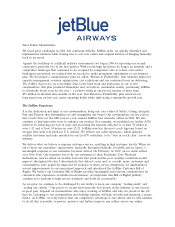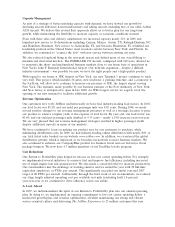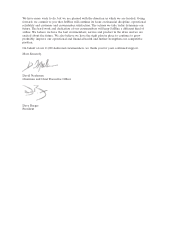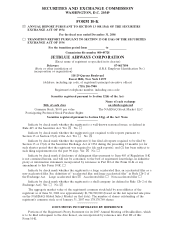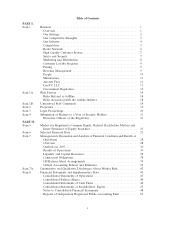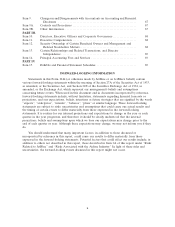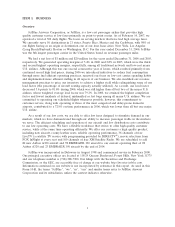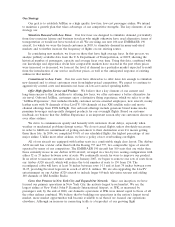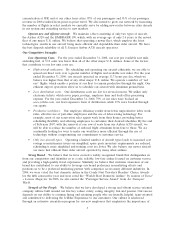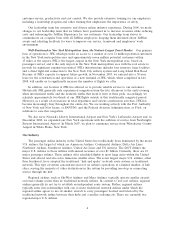JetBlue Airlines 2006 Annual Report Download - page 4
Download and view the complete annual report
Please find page 4 of the 2006 JetBlue Airlines annual report below. You can navigate through the pages in the report by either clicking on the pages listed below, or by using the keyword search tool below to find specific information within the annual report.Capacity Management
As part of a strategy of better matching capacity with demand, we have slowed our growth by
deferring aircraft deliveries from manufacturers and selling aircraft, including five of our older Airbus
A320 aircraft. We believe this revised fleet approach allows us to better plan for our long-term
growth, while maintaining the flexibility to increase capacity as economic conditions warrant.
Even with these sales and delivery adjustments, we increased capacity nearly 21%in 2006 and
launched new service to 16 destinations including Cancun, Mexico, Austin, TX, Raleigh-Durham, NC,
and Hamilton, Bermuda. New service to Jacksonville, FL and Sarasota Bradenton, FL solidified our
leadership position in the United States’ most traveled corridor between New York and Florida. In
addition, we continued to ‘‘connect the dots’’ with new service between existing city pairs.
We also reduced long-haul flying in the non-peak season and shifted more of our overall flying to
medium and short-haul markets. The EMBRAER 190 aircraft, configured with 100 seats, allowed us
to penetrate the short- and medium-haul business markets close to our home base of operations in
New York’s John F. Kennedy International Airport. Our network expansion – despite a difficult
industry environment – was possible because we have the right people and a high-quality product.
With regard to our home at JFK Airport in New York, our new Terminal 5 project continues to track
very well. This project, which includes 26 gates, new roadways, a parking structure, and a connector to
the AirTrain, will allow us to continue to increase our presence at JFK, the largest airport serving
New York. The terminal, made possible by our business partners at the Port Authority of New York
and New Jersey, is anticipated to open in late 2008. As JFK’s largest carrier, we eagerly await the
opening of our new terminal to facilitate additional growth.
Revenue Optimization
Our customers love to fly JetBlue and historically we have had industry-leading load factors. In 2005,
our load factor was 85.2%and our yield per passenger mile was 8.02 cents. During 2006, we made
several positive changes to our revenue management processes as well as a strategic decision to price
our product to achieve a higher yield, at the expense of load factor. By year end, our load factor was
81.6%and our yield per passenger mile climbed to 9.53 cents – nearly a 19%increase year-over-year.
We are very pleased that our revenue management strategies resulted in higher passenger yields
despite additional capacity in many of our markets.
We have continued to focus on making our product easy for our customers to purchase, while
minimizing distribution costs. In 2006, we had industry-leading online distribution with nearly 80%of
our total ticket sales booked on our website www.jetblue.com. In addition, we re-entered the global
distribution systems, which is important as we broaden our network to more business markets. We
also continued to enhance our CompanyBlue product for business travel and our Getaways travel
package business. We now have 4.7 million members of our TrueBlue loyalty program.
Cost Reductions
Our Return to Profitability plan helped us refocus on low-cost carrier spending habits. For example,
we implemented several initiatives to conserve fuel and improve fuel efficiency, including increased
use of single-engine taxi and ground power. We also made a concerted effort to increase productivity.
Our crewmembers met the challenge of working smarter and we ended the year with 78 full-time
equivalent employees, or FTEs, per aircraft. This significantly exceeded our initial year-end 2007
target of 80 FTEs per aircraft. Additionally, through the hard work of our crewmembers, we reduced
our stage length adjusted operating cost per available seat mile (excluding fuel) 1.4 percent
year-over-year as we continued to drive efficiency across our airline.
A Look Ahead
In 2007, we institutionalized the spirit of our Return to Profitability plan into our annual operating
plan. In doing so, we implemented an ongoing commitment to low-cost carrier spending habits, a
moderated growth plan, and revenue optimization, all while maintaining our strong and vibrant
service-oriented culture and delivering The JetBlue Experience to 23 million customers this year.



